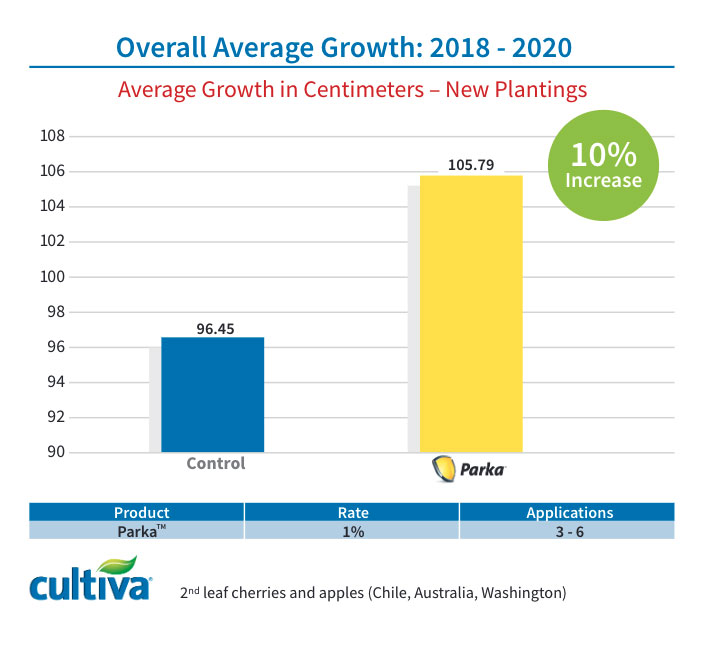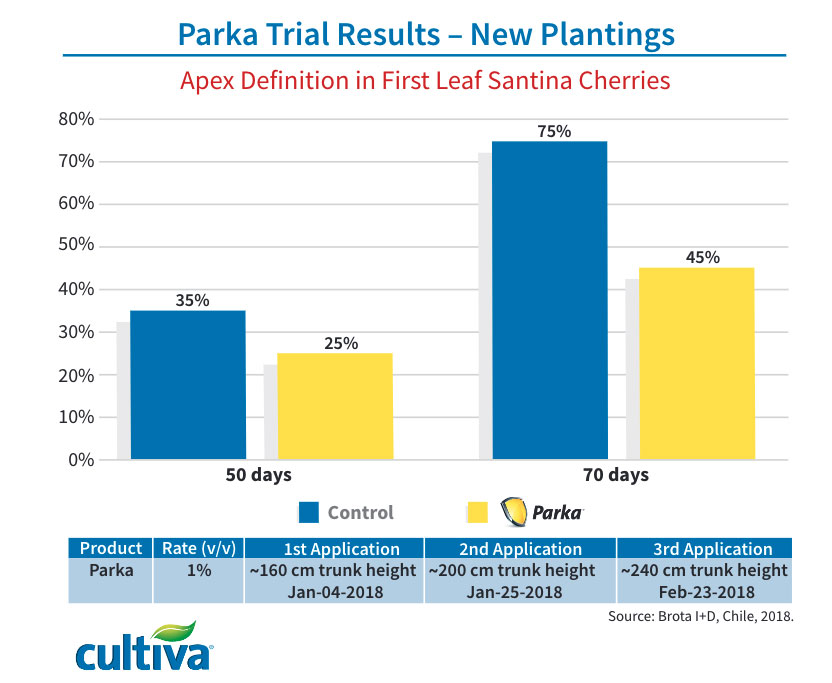Supplementing the Cuticle of the Leaf Accelerates Plant Growth
Growers of permanent crops make a significant effort of money and time when they plant new young plants. The return on investment can range from 2-10 years, depending on the crop. In the meantime, these small plants are especially vulnerable to environmental stress until their root systems are fully established. By supplementing and stabilizing the cuticle of the foliage and young shoots, Parka makes the plant more tolerant of heat and moisture stress by increasing the plant’s antioxidant capacity. Antioxidants are a physiological tool the plant uses to mitigate the effects of detrimental conditions. This reduction in plant stress means improved photosynthetic activity and better water and nutrient uptake. Most crucially, it delays apex definition, extending the growth period.
Parka has been shown to increase concentrations of chlorophyll and pheophytin—both critical molecules in photosynthesis. By increasing the plant’s photosynthetic capacity as well the level of antioxidants that help to supplement and stabilize the cuticle, Parka can help young plants stay healthy through the critical establishment period.


Why use Parka on New Plantings?
- Increases plant tolerance to environmental stress.
- Slows apex definition by reducing the impact of environmental stress.
- Easily tank mixed with foliar nutritionals and pesticides
- Only a small amount—just a 1% concentration—of Parka is needed.
- Does not leave residue on foliage.
- Exempt from maximum residue levels
- Zero preharvest interval, zero worker reentry interval
How to Use Parka in a Program
For new plantings, the best results have been obtained with applications later in the season when temperatures rise. In areas exposed to frequent wind, it may be beneficial to apply Parka throughout the entire season at 14-day intervals. Since Parka can be tank mixed with many crop protection and nutritional products, it is easy to include it with those applications. To achieve results on new plantings, only a 1% concentration by water volume is required.
For a later-season program, begin application when day temperatures reach 85°F (30°C). Apply twice more at 14- to 30-day intervals.
FAQ
How Does Parka Reduce Environmental Stress and Slow Apex Definition?
When a young plant is stressed by external or internal factors, it responds by slowing or stopping growth. In young shoots, it causes premature apex definition, a physiological process by which the apex, or growing tip, hardens and stops growth until the following season. By increasing the plant’s capacity to resist environmental stress, apex definition is not initiated, and the shoot continues to grow.
Parka helps young plants resist environmental stress in several ways. The physical protection of the leaf cuticle with a clear, hydrophobic and elastic lipid bi-layer reduces transpirational water loss from wind and heat.
However, Parka also supplements and stabilizes the cuticle itself. It also increases the plant’s photosynthetic capacity by increasing the amounts of chlorophyll and a molecule called pheophytin. During the first phase of photosynthesis (the PSII complex), chlorophyll captures the energy from the sun, and this energy is used to split a water molecule. The “excited” electron released from this splitting is received by pheophytin.
Parka-treated plants show increased photosynthetic efficiency of the PSII complex. Transpiration rates, CO2 exchange and stomatal conductance were all improved. Parka also increases the plant’s antioxidant capacity, which improves its ability to handle abiotic stressors such as heat and drought.

What Crops Benefit from Using Parka on New Plantings?
So far, research has shown that permanent crops including apples, cherries, walnuts, and almonds show increased growth and resistance to stress when Parka is applied in the early growth years. Further research is being conducted on citrus, grapes and ornamental crops.
What Do Growers Like About Parka?
First and foremost, growers like Parka because it works. It is grower-friendly in other significant ways, as well, particularly its flexibility in tank mixing. Parka can be tank mixed with a wide variety of other foliar inputs, including fertilizers and pesticides. This saves the fuel and labor costs of making an additional pass in the field. Field workers crews like Parka, because it does not have the residue that can be an irritant while pruning.


